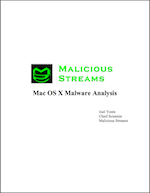
Research Portfolio
Digital Forensics of Robotic and IoT Systems
In our connected world, computing platforms are no longer restricted to traditional workstations and servers. Today, computing power is being embedded in everything from industrial systems and robotics to consumer electronics. This advancement in technology greatly improves the capabilities of these technologies but also has the affect of greatly increasing the digital attack surface and complexity of incident response. To compound this issue, these technologies have an escalating level of control over our physical world creating a potential for physical threat in addition to the traditional cyber-related scenarios. Research in this area is focused on defining the processes and building the tools needed to provide digital forensics and response capabilities for these emerging platforms.
Digital Protection and Forensics of Artificial Intelligence Systems
With the rise of modern artificial intelligence systems, AI has moved from a curiosity to a powerful system for analyzing and controlling our world. We have seen great gains because of this technology in fields such as transportation, health care, financial industries, manufacturing, retail and national defense. Research in this area includes understanding new attack vectors such as AI poisoning, auditing and protecting artificial intelligence systems, and digital forensics of artificial neural networks.
Published Articles
-

Attributes of Malicious Files
Malware has become a common component to most modern intrusions. Confirming a system is infected or finding the attacker-‐planted backdoor can be a daunting task. To compound the situation, attackers are taking steps to actively evade traditional detection mechanisms. The foundations laid in this paper begin to develop an alternate and supplementary approach for identifying malware through detecting anomalies in the low‐level attributes of malicious files. Over 2.5 million malicious samples were analyzed and compared with a control set of non-malicious files to develop the indicators presented.
-

Building A Malware Zoo
Today malware circulates in mass volume. New samples appear at a rate of thousands per day. In order to keep pace and manage this analysis demand two key needs emerge: automation and organization. This paper seeks to lay the foundation for a basic Malware Zoo that will provide a framework for both.
-

Digging for Malware: Suspicious Filesystem Geography
Malware has moved to the forefront of the information security landscape. Malicious software is involved in nearly every major data breach. While host-based anti-malware products are a must, they are not getting the job done entirely. The flood of ever changing malware continues to flow over the walls of protection and into our systems. Once malicious files have embedded themselves, the challenge falls on the incident responders and forensics experts to identify, contain, and eradicate these threats. This article will explore ways to discover malware by identifying suspicious filesystem locations most commonly used by malware.
-

PDF Malware Overview
As far back as 2001 (Peachy Worm) we have seen cyber criminals utilize embedded malicious scripts and other dynamic PDF features to install malware and steal user credentials. While the goals and technical payloads of these PDFs have changed over the years, the pattern for creating a malicious PDF remains largely unchanged.
-

Low Tech Ransomware
Recently, I had the opportunity to analyze a new ransomware Trojan. What I found was an interesting sample that relied more on social engineering than on advanced tech to extort money from the end user.
-

PDF Malware: Pidief
PDF viewers can be found (and normally pre-installed) on all major computing and mobile platforms making it the most popular document format available today. Without surprise this popularity and adoption has gained the attention of malware authors.
-

Identifying Persistence on Mac OS X
The need to persist tools and infections between reboots is critical for the cyber criminal. In the Microsoft Windows world, we have an established body of knowledge and tools for determining programs set to launch at startup. This same level of maturity does not exist for the Mac OS X platform. Even though details of OS X’s startup systems have been widely published, there is a lack of dissemination of this information within the Forensics community. Further, there exists a gap in open source tools to aid in the compilation of OS X startup items. The intent of this article is to explore the startup mechanisms of OS X and to introduce a basic tool to help with the examination of Mac OS X systems.
-

Malicious Social Networking: Koobface Worm
The popularity of social networking sites such as MySpace and Facebook has sky rocketed in recent years. Today nearly everyone has a profile and established friends lists that are used to keep tabs on your two hundred closest friends. For most, the motive behind these sites lies somewhere between a genuine interest in keeping in touch with friends and family to keeping up with the latest gossip. This popularity hasn't gone unnoticed to the malcode authors. To these authors, social engineering is a key tactic used to get their wares installed on unsuspecting victims. Social networking sites make socially engineering victims almost too easy.
-

Mac OS X Malware Analysis
As Apple's market share raises so will the Malware! Will incident responders be ready to address this rising threat? The intent of this paper is to begin building a basic Mac OS X malware analysis capability to deal with the potential of Mac Malware.
-

OS X Puper.A (RS-Plug.F)
OS X Puper.A by most accounts has been the most popular Mac OS X malware in the past 18 months. What is most fascinating is how little sophistication is involved in this threat and yet how it continues to be a viable threat for the Mac platform. Read the analysis report for details.
-

Fujacks: A Modern File Infector
Fujacks was an interesting malware species that helped re-introduced the file infector behavioral into today’s blended threat. This analysis report focuses on the reproductive behavioral of this modern file infector.


